2021 Mazda CX-30 40K-Mile Test: One Turbo Short of Excellence

40,000-Mile Wrap-Up
If we learned one thing over the course of 40,000 miles with the Mazda CX-30, it's that you should get the 2.5 Turbo. Mazda is attempting to pull itself into the luxury class, and the CX-30's standard engine just undermines that effort. The CX-30 redeems itself in other areas, though, and is Mazda's second-highest seller behind the CX-5.
We took delivery of a Deep Crystal Blue CX-30 shortly after we said goodbye to a 2019 Mazda CX-5 Turbo. That CX-5 was equipped with the more powerful turbocharged engine and was a multiple 10Best-award winner. We wanted to see whether our love for the Mazda trickled down to the smaller CX-30. It did—for the most part.
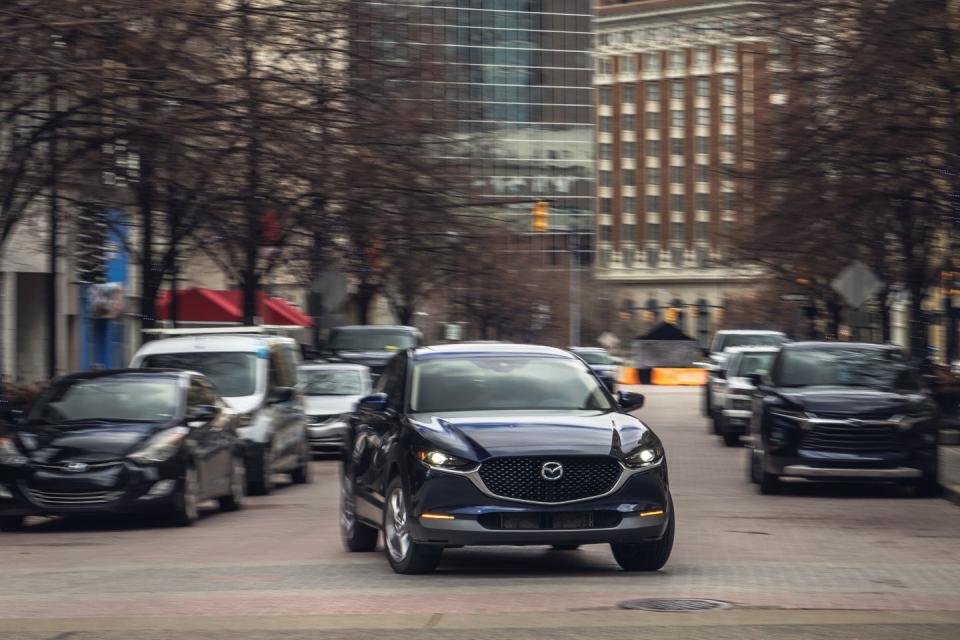
Although we lamented not getting the turbocharged engine, the standard 186-hp 2.5-liter does enjoy slightly higher EPA fuel-economy estimates: 24/31 mpg (city/highway) versus 22/30. And over the course of 40,000 miles, we observed 28 mpg, which is 2 mpg better than the EPA combined estimate. At the test track, our CX-30 managed a 7.5-second run to 60 mph. That pales, however, in comparison to the 250-hp turbo model's 5.8 seconds, a time that makes it competitive with German luxury subcompacts.
Other than including the Preferred package, which adds heated front seats, a power sunroof, and power driver's seat with memory, our test car was rather lightly optioned. It had a stainless rear bumper guard for $125 and all-weather floor mats for $150. For the 2022 model year, Mazda gave the CX-30 standard all-wheel drive and added a new Carbon Edition with a red interior and 18-inch black wheels.
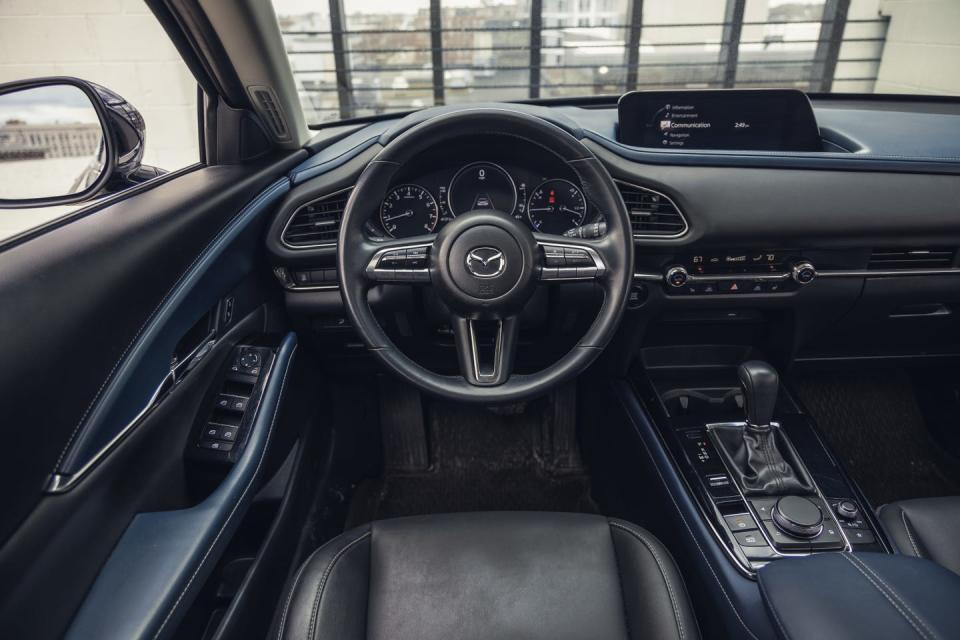
Most of the CX-30's praise revolved around its upscale interior. We appreciated the way the black and navy-blue leather interior paired with the dark-blue exterior. Commenters said it "could pass as a luxury model" and that it "looks and feels so premium compared with the rest of the segment." One staffer even went as far as saying it "makes a strong case for itself as a budget alternative to the likes of the BMW X2, the Mercedes-Benz GLA-class, and the Lexus UX." At an as-tested $29,075, that claim isn't as outlandish as it might seem.
In addition to the lack of forced induction, there were small annoyances that set the CX-30 back. The automatic parking brake that's engaged every time the car is started earned the most ire. Mazda seems to have been listening because for the 2022 model year, the parking brake now releases when the car is shifted out of park. A few of us called out the adaptive cruise control and lane centering for slow reactions and not keeping the car centered in the lane. The low-res backup camera was another annoyance. Overall, though, as senior editor Joey Capparella put it: "The Mazda is a pleasant, competent entry in this segment. I give it a lot of credit for that and can overlook most of its small annoyances."
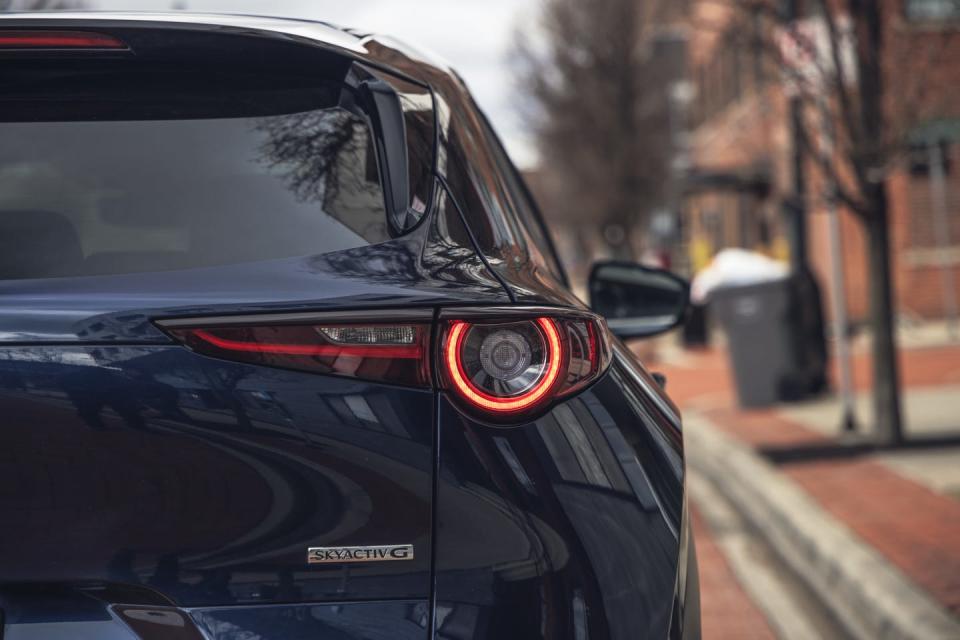
Over 40,000 miles, our CX-30 cost us $781 in service and just $4086 to keep it supplied with regular fuel. In the winter months, we swapped out the all-season tires for a set of Nokian Hakkapeliitta R3 SUV winter tires. All in all, the tires and brakes wore normally. Based on their wear during our 40,000 miles, we predict the original-equipment Bridgestone Turanza all-season tires would go 60,000 miles and the brakes between 85,000 and 90,000 miles. And we had zero surprises in terms of wear items or other out-of-pocket repairs.
With the arrival of the new CX-50 and the coming longitudinal-architecture models, Mazda is reinventing itself as an upmarket player. While we had some issues the brand's entry-level SUV, we still think it's a credible entry point for the Mazda brand. The turbo engine, though, would make it more so.
Months in Fleet: 19 months Current Mileage: 40,156 miles
Average Fuel Economy: 28 mpg
Fuel Tank Size: 12.7 gallons Observed Fuel Range: 350 miles
Service: $781 Normal Wear: $0 Repair: $0
Damage and Destruction: $93
30,000-Mile Update
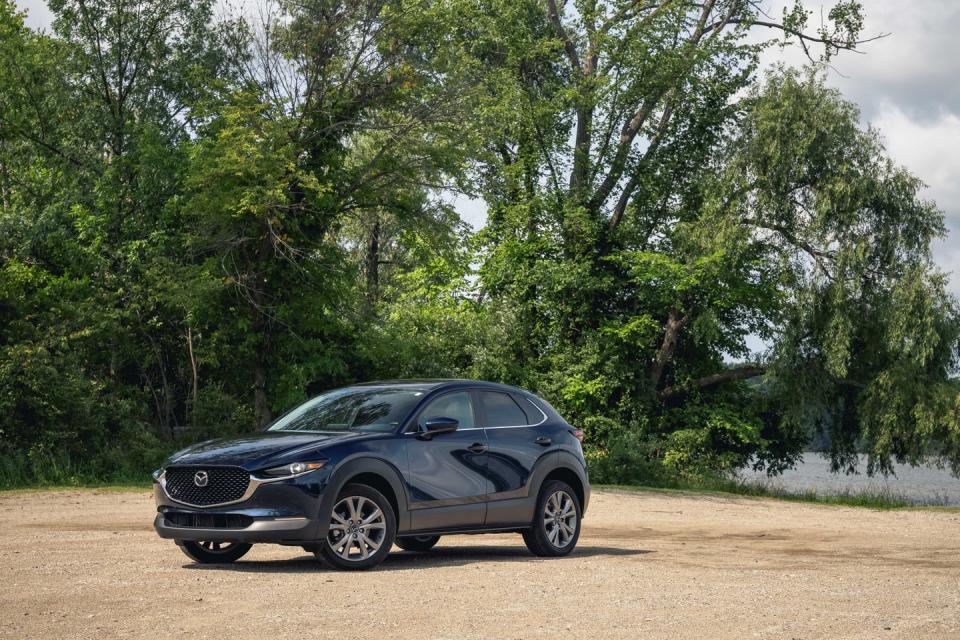
The 30,000-mile mark is often a tough milestone for a car in our long-term fleet. As a vehicle approaches the end of the test, we're either still as enthralled with it as when it was new, it's causing us some headaches, or our opinions on it are mostly cemented in place. With our Mazda CX-30, we quickly learned what we do and don't like—which you can read about in past updates—but overall it's not as popular among our staff as the larger CX-5 that won our 10Best award four years in a row.
Whereas the CX-5 made us appreciate compact crossovers, the CX-30 makes us question the idea of small, lifted hatchbacks disguised as SUVs. But they continue to sell. Through November, the CX-30 has outsold the Mazda 3 sedan and hatchback by some 20,000 units. Even so, numerous staffers have complained about the lack of room in this small SUV, especially in the rear when four adults are crammed in. The lack of spaciousness still hasn't prevented drivers and passengers from praising this Mazda's upmarket interior, though.

Some small annoyances that have bothered drivers are the excessive safety-system beeps and the pesky automatic parking brake, which engages automatically every time the car is started. "I didn't set the brake, so let me go!" exclaimed testing director Dave VanderWerp. Senior editor Joey Capparella believes the reason we're noticing these things is because the CX-30's "driving experience is so smooth and seamless otherwise." That may be so, but we still wish we had the optional turbocharged engine.
While the CX-30 is rarely the first choice among our current long-term stable for staffers to take on long journeys—especially now that there are two minivans in the lineup—that hasn't kept the Mazda stuck in our home state of Michigan. Our observed fuel economy has remained at 28 mpg after journeys to Virginia for our annual Lightning Lap event; Columbus, Ohio; Green Bay, Wisconsin; and Brooklyn, New York.
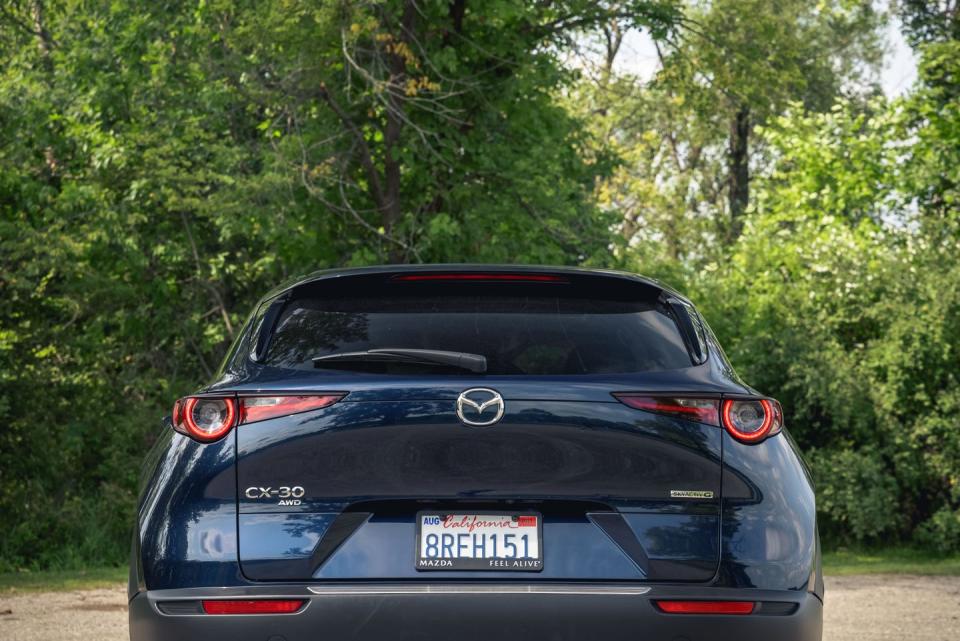
Our Mazda has been trouble-free since our last report at 20,000 miles, needing only routine maintenance. Those intervals are 10,000 miles for the standard schedule, and the most recent service at 30,776 miles cost $196, where the dealer performed an oil and filter change, cabin air filter replacement, tire rotation, and inspection. And with winter approaching, we installed a set of Nokian Hakkapeliitta R3 winter tires.
With 10,000 miles to go, we're satisfied with Mazda's smallest SUV but not as enamored as we were at this point with the CX-5. Like the CX-5, however, our CX-30 keeps its perfect reliability record.
Months in Fleet: 14 months Current Mileage: 31,121 miles
Average Fuel Economy: 28 mpg
Fuel Tank Size: 12.7 gallons Observed Fuel Range: 350 miles
Service: $538 Normal Wear: $0 Repair: $0
Damage and Destruction: $93
20,000-Mile Update
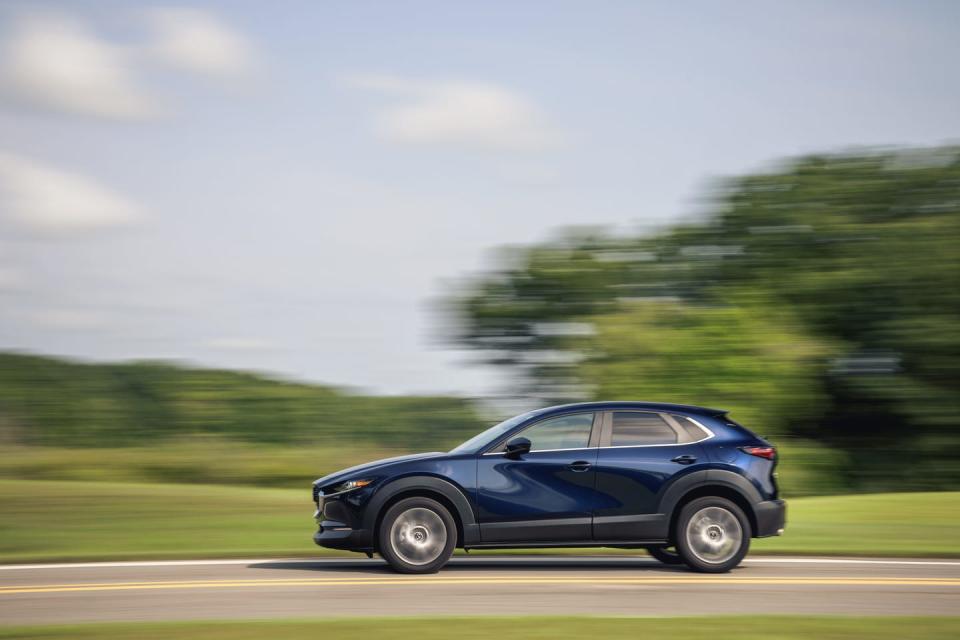
Mazda is maturing into a luxury brand, and our CX-30 is feeling the effects. We've noted previously that if we had the optional turbocharged 2.5-liter engine it would help it feel more upmarket, but Mazda's mentality leans toward luxury in the inside too. So, we're seeing if our little Mazda can make up for its lost grunt in the space where we spend the most time.
Our test car's two-tone black and navy-blue leather interior sets the upscale vibe. The dark-blue elements pair well with our car's Deep Crystal Blue paint job, covering the top of the dashboard, armrests, and parts of the center console. Metal rings around the infotainment and climate controls that turn with precision also help give this Mazda a sense above its price range. Staff editor Annie White applauded the materials, saying Mazda "does a good job of packing luxurious-feeling features into an affordable package." It's true. Ours cost just under $30,000.

Staff editor Eric Stafford was initially hard on the CX-30's cabin, however, saying it "lacked the true upscale quality of most Mazdas." He came around after a 2000-mile road trip to his hometown in Michigan's Upper Peninsula. "I was a fool," he says. "The CX-30 is classy, sporty, and well-equipped." Although he did note the interior plastic as cheap, Stafford declared the CX-30 could still pass as a luxury model.
When cruising, the cabin is more serene than its luxury rivals. In our initial test, we recorded 70 decibels at a 70-mph cruise, which is two decibels quieter than a few compact luxury SUVs such as the Audi Q3 and BMW X1. However, multiple drivers have complained about obnoxious safety-system warning beeps. And our little ute still lacks some of the luxury niceties we've grown accustomed to. The main offenders are the lack of satellite radio, navigation, a heated steering wheel, and wireless charging, something that's even available on the new Honda Civic.
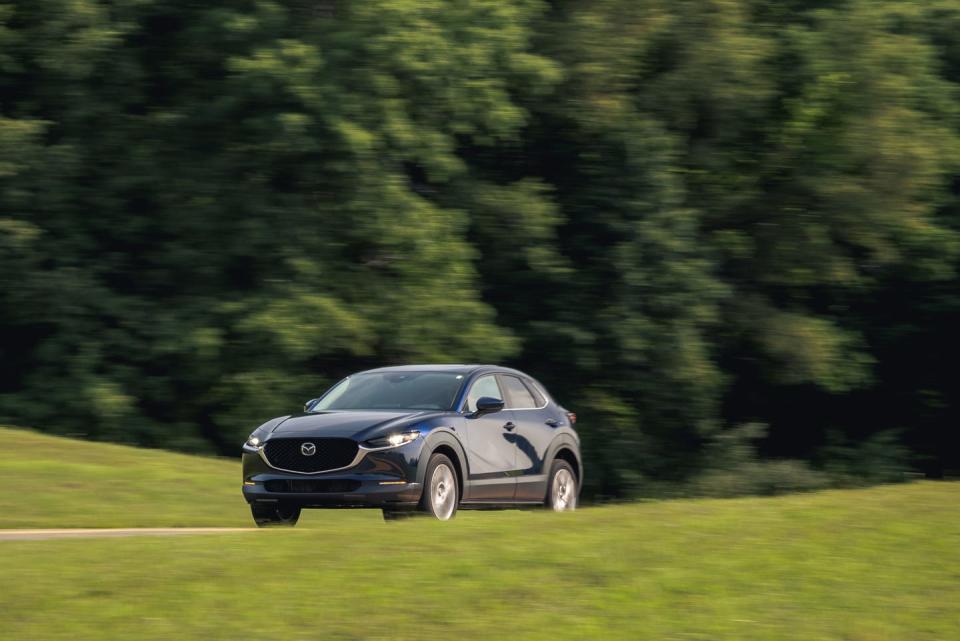
Since we last checked in, travel to the Upper Peninsula as well as New Jersey, Wisconsin, Indiana, and Georgia have brought our overall observed fuel economy up to 28 mpg. After 20,000 miles, minus the bucket that destroyed the plastic under the front bumper (see our 10,000-mile update), we haven't run into many issues with the CX-30. At 11,375 miles, we noticed that the rear passenger tire wasn't holding air, so we took it to Discount Tire, and they patched it free of charge. A routine maintenance at 20,000 miles required an oil change, tire rotation, brake-fluid flush, and a multipoint inspection for $235.
In a recent comparison test, albeit an unconventional one where we didn't crown a winner, we put the CX-30's smaller sibling, the Mazda 3, against the Audi A4 to see how realistic Mazda's luxury ambitions really are. If the automaker keeps it up and can pull off its coming new platform and inline-six engines with its larger models, it'll be awfully close. We'd say the same thing for our CX-30, which is proving that what's inside still counts—even if we can't get over what's under the hood.

Months in Fleet: 11 months Current Mileage: 20,097 miles
Average Fuel Economy: 28 mpg
Fuel Tank Size: 12.7 gal Observed Fuel Range: 350 miles
Service: $342 Normal Wear: $0 Repair: $0
Damage and Destruction: $93
10,000-Mile Update
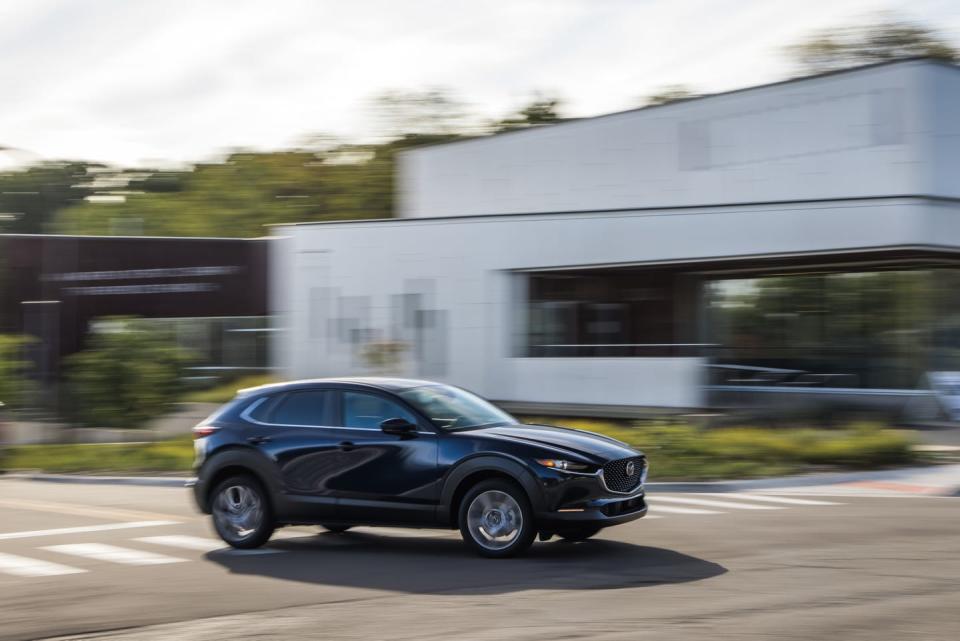
Save for a misplaced plastic bucket in the middle of a highway, the first 10,000 miles with our Mazda CX-30 have been uneventful and about what we expected. We'll get to the bucket in a minute, but first let's talk about our initial thoughts on the CX-30—one specific to its segment, the other to the car itself.
As we see it, most small crossovers would work better as cars. In the case of the CX-30, the car it could be already exists: the Mazda 3 hatchback. But subcompact SUVs are popular, so Mazda created the CX-30, debuted it for the 2020 model year, and watched it sell more units than every other vehicle in its lineup except for the one-size-up CX-5. That pace hasn't changed this year. Through April, the CX-30 outsold both the Mazda 3 and the slightly smaller CX-3 crossover combined.
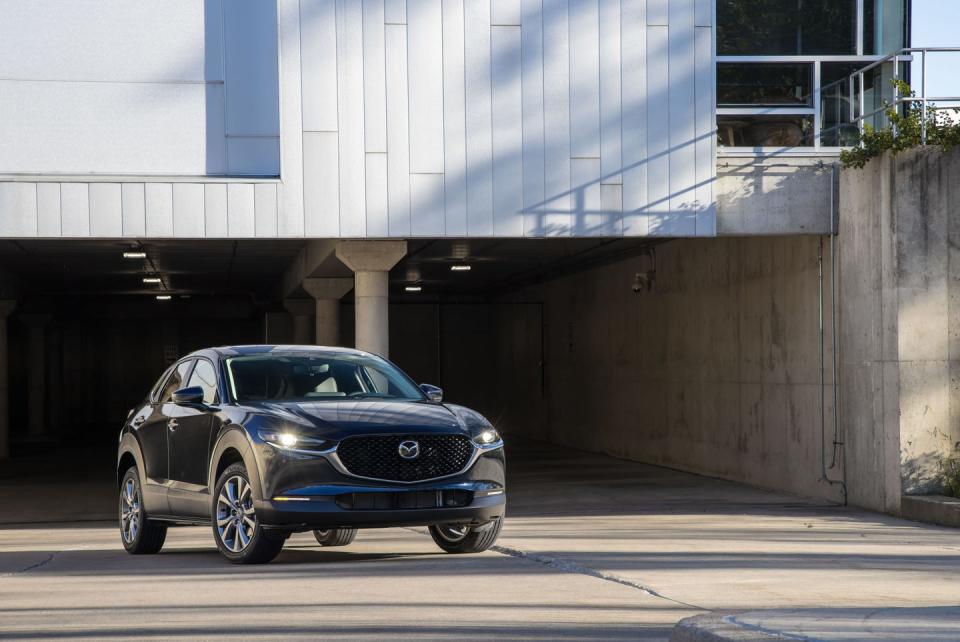
The only real change to the CX-30 for 2021 is the addition of an optional turbocharged 2.5-liter inline-four that produces 250 horsepower. Our long-term test car doesn't have that engine and, as we could have predicted, the Turbo model changes the SUV's math. In our testing, the boosted engine gets the CX-30 to 60 mph in 5.8 seconds versus 7.6 for our example with the standard 186-hp four. Just as noteworthy is the 1.1 seconds that the turbo engine lops off the regular CX-30's 50-to-70-mph time, which makes it far wieldier during passing maneuvers.
"Having spent a lot of time in the turbo version, not having the extra power really sucks the upscale vibe out of this thing," senior online editor Mike Sutton wrote in our CX-30's logbook. "It's quick and responsive enough, though. Good, linear steering and nice general body control. A good driver, but the same goes for the 3 hatch."

For C/D staffers less encumbered by seat time in the turbo, however, our regular CX-30 has quietly impressed as it's trekked up, down, and across Michigan. It hasn't left the state yet, but it's averaging a decent 27 mpg—1 mpg more than its EPA combined estimate—and summer road-trip season is nearly upon us.
Staff editor Eric Stafford took the CX-30 and his skepticism—"I haven't been a fan," he prefaced—on a nearly 2000-mile jaunt through Michigan's Upper Peninsula. He came away calling the vehicle "classy, sporty, and well equipped." The CX-30's 20 cubic feet of cargo space was sufficient for his needs, and he found enough back-seat room for adults. "While the 2.5-liter is gruff when pressed, it's plenty potent and operates quietly enough in normal driving," he wrote. Indeed, our Mazda's 68-decibel sound measurement at 70 mph is the same as the Turbo model's, and it puts the CX-30 in the company of the Mercedes GLA250. "Too bad its driving range is short. I averaged right around 300 miles per tank, which required extra stops on my long trip."

A few other criticisms have creeped into the logbook. The sometimes wonky activation of the car's automatic high beams can make for a challenging drive on foggy nights. The CX-30's adaptive cruise control sometimes will brake harder and more suddenly than we expect when approaching slower vehicles. "You should never design a heated seat control near a cupholder," noted creative director Darin Johnson. He didn't elaborate, but we assume he cleaned up whatever he spilled reaching for the seat heaters.
But our first 10,000 miles have largely been spent pondering how the CX-30 fits in Mazda's lineup, as well as how it stacks up with competitors such as Kia's Soul and Seltos and Hyundai's Kona and Venue. "I don't see why some people are confused about the CX-30's mission," buyer's guide deputy editor Rich Ceppos wrote. "It's the right-sized subcompact SUV that the CX-3 should have been in the first place—the cargo-friendly analog to the Mazda 3 sedan."
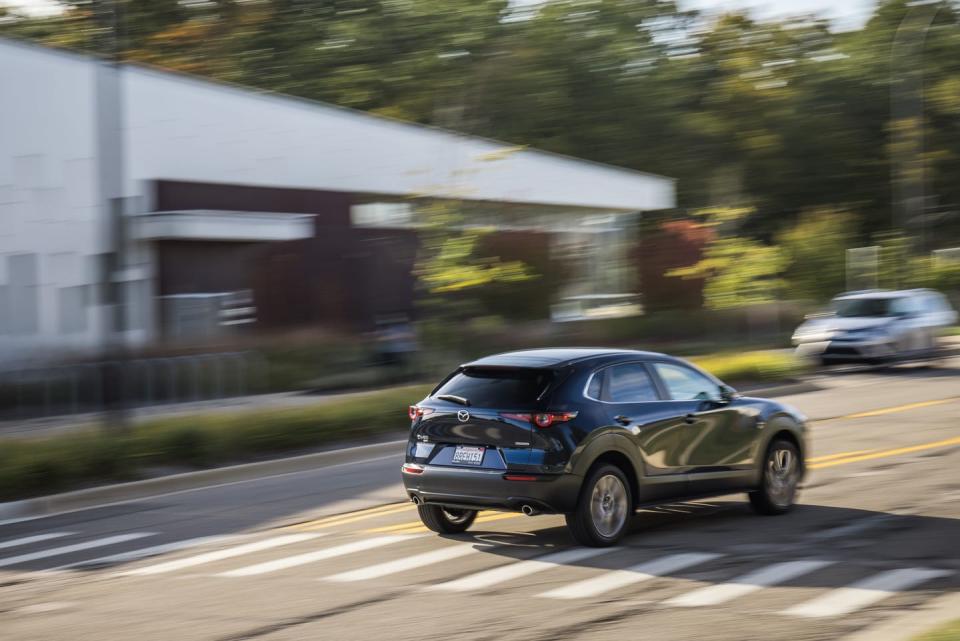
As for that bucket, it was blue, plastic, and it appeared out of nowhere on our local stretch of M-14. Ceppos, stuck in the center lane, didn't have any choice but to hit it. The result was a baseball-sized hole in the plastic panel under the CX-30's nose. We had the dealer inspect the damage when we dropped the vehicle off for its scheduled 10,000-mile service, which included an oil and filter change and a tire rotation at a cost of $107. Replacing the panel relieved us of another $93 and entailed an overnight stay while the replacement part was ordered.
Aside from that mishap, it's been a solid start to the CX-30's 40,000-mile test. "Sweet steering, sharp throttle response, fun handling—yep, this is a Mazda alright," Ceppos wrote. His only suggestion? It could benefit from the turbocharged engine.
Months in Fleet: 7 months Current Mileage: 10,696 miles
Average Fuel Economy: 27 mpg
Fuel Tank Size: 12.7 gal Observed Fuel Range: 340 miles
Service: $107 Normal Wear: $0 Repair: $0
Damage and Destruction: $93
Introduction

In 2019, when we took the keys to a CX-5 for a 40,000-mile long-term test, we wrote that "Mazda has few obvious problems." The CX-5 supported that conclusion, proving "easy to love," earning 10Best honors in 2020 and 2021, and exhibiting uncommon excellence despite belonging to a segment we generally greet with a resigned sigh.
We tolerate compact SUVs because they're popular, but we celebrate Mazdas because they're good. The tension between those ideas, plus the rising popularity of small SUVs, makes for interesting work. The CX-5 won us over. So, let's up the degree of difficulty.
The CX-30 is a subcompact SUV, a segment that typically prompts a single frustrated question: Why aren't you a car? Recall, if you will, our review of the 2020 CX-30, which began, "Have you considered the Mazda 3?"
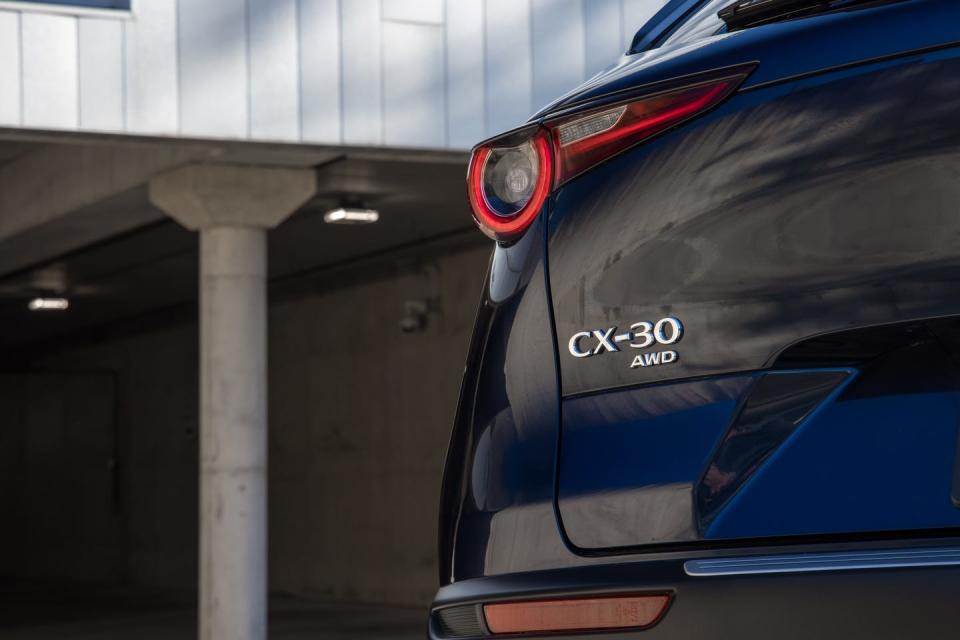
The 3 is roughly the same size as the CX-30, give or take a tuck or tweak here and there, and it's available as a hatchback. We like the 3 a lot. Despite already building the 3 and a similarly sized crossover, the CX-3, Mazda introduced the CX-30 for 2020. Why? Because people like to sit a little higher these days, and higher sells.
Any other reasons? We're about to find out over 40,000 miles with a 2021 CX-30. Now in its second production year, Mazda didn't change much from the CX-30's debut run except to add an optional turbocharged 2.5-liter engine that's good for 250 horsepower.
"I heard we got the non-turbo," staff editor Austin Irwin messaged shortly after the CX-30 arrived. To ensure his feelings were clear, he punctuated the sentence with a sad-face emoji.
We did not get the turbo. Sad-face emoji.

Our all-wheel-drive CX-30 came with the standard 2.5-liter inline-four and six-speed automatic transmission. It makes 186 horsepower and ran to 60 mph in 7.6 seconds in our initial testing. It hit the quarter mile in 15.9 seconds at 89 mph and pulled 0.85 g on the skidpad. Those are decent numbers. The Mazda 3 2.5 Turbo we recently tested did zero to 60 mph in 5.6 seconds. Just pointing that out.
The CX-30 starts at $23,000, which is $155 less than the "all-wheel drive is standard" base Subaru Crosstrek and $4390 more than the "it's front-drive or no drive" Kia Soul. There's value in the CX-30 in either direction, even when tacking on the $1400 for all-wheel drive.

We got the Preferred Package, which includes a power driver's seat, memory positioning for the exterior mirrors, heated front seats, a power sliding-glass moonroof, and driver's seat memory. But we stayed light on options for this one. We picked up all-weather floor mats ($150) and a rear bumper guard ($125). That's it. The as-tested price totaled $29,075. We took delivery and promptly set about running SUV-like errands in our SUV-like car (or our carlike SUV).
The first coffee spill came on a run to City Hall to drop off a ballot. The first grownup shunted to the back seat (kids are quick to grab the heated front passenger seat) surveyed her surroundings and said, "They make the most of the space they've got back here." A quick run to the driving range revealed that golf clubs fit in the aft cargo area without folding the rear seats. Barely.

Since we're still working from home, we ran some simulated commutes through town, out on country roads and on the highway. We recommend the country drive, especially in autumn. It's lovely, and there are just enough twists and turns to prove the CX-30 moves like a Mazda. It's playful enough to be fun.
The black on navy interior with leatherette seats and a leather-wrapped steering wheel makes for high-quality company. The 8.8-inch infotainment screen is fine, and Android Auto and Apple CarPlay come standard at the Select Package level. (That's one down from our Preferred.) The Deep Crystal Blue Mica paint job has already earned compliments. If there are quirks to be found, our planned lap and a half or so around the Earth should shake them out.
"Such a comfortable little medium SUV" begins the first entry in the logbook, which brings us back to our 40,000-mile challenge: What exactly is the CX-30, and why does it exist?

We had a different CX-30 at this year's 10Best testing and comments ranged from "true to the Mazda ethos" and "much more in the realm of Audi and BMW than Chevy and Toyota" to "just get the Mazda 3."
Have you considered one of those?
Of course, you have. Through October, Mazda sold nearly 28,000 3s in North America in 2020, but that's down almost 37 percent from the same point a year ago. The CX-3's sales numbers this year are also down, by 27.5 percent (7485 sold). The upshot for Mazda is that those declines could be ascribed to the appeal of the CX-30, which moved 31,007 units through October. In the Thunderdome of Mazda dealerships, the CX-30 is thriving, and Mazda buyers appear to (narrowly) prefer it to the 3. We'll let you know if there needs to be a recount.
Months in Fleet: 2 months Current Mileage: 3597 miles
Average Fuel Economy: 28 mpg
Fuel Tank Size: 12.7 gal Observed Fuel Range: 350 miles
Service: $0 Normal Wear: $0 Repair: $0
Damage and Destruction: $0

You Might Also Like

